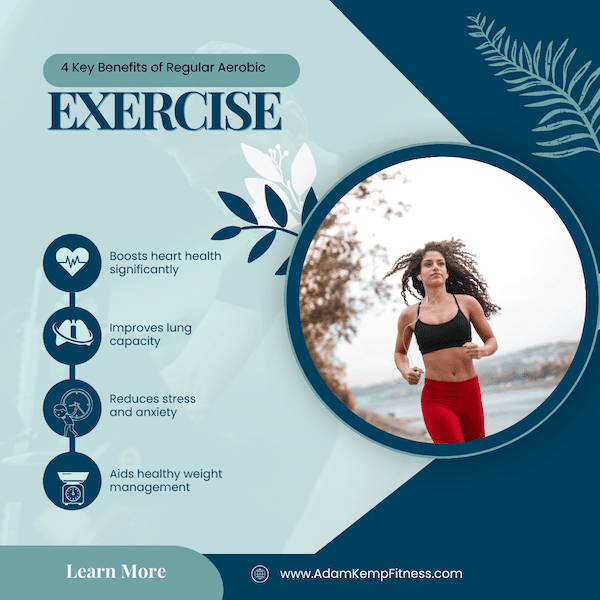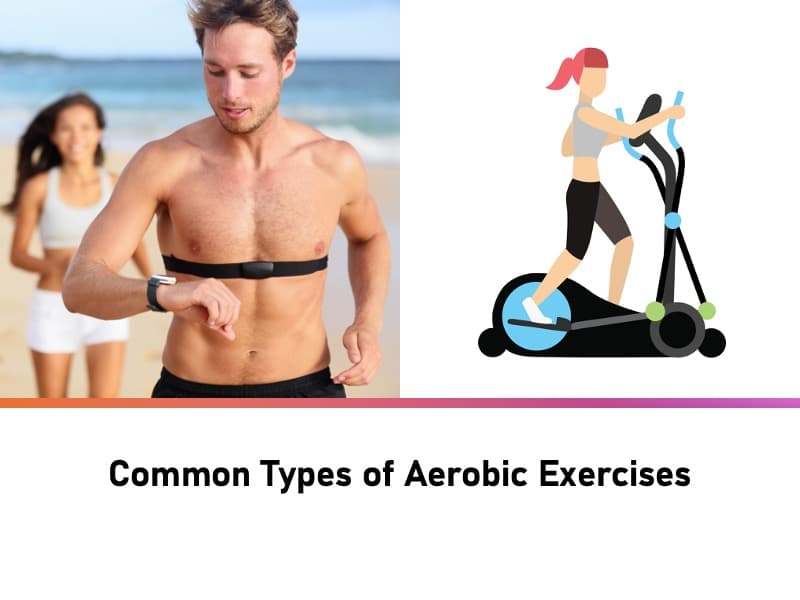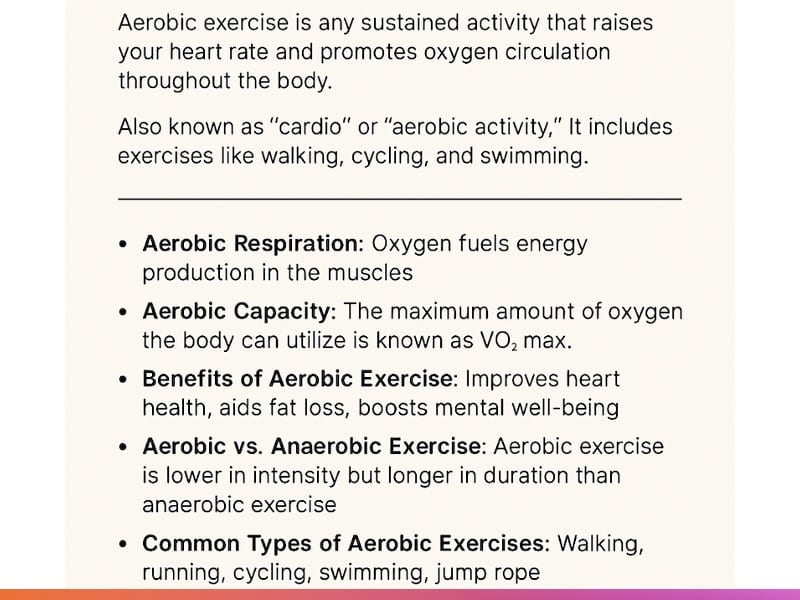Aerobic Exercise: Benefits, Physiology, How to Do, Examples
Aerobic exercise is a foundational pillar of long-term health and fitness.
Known for improving cardiovascular endurance and supporting fat metabolism, aerobic exercise involves sustained movement that uses oxygen as the primary energy source.
Whether you’re walking briskly or swimming laps, aerobic cardio workouts challenge the body in a unique way, enhancing both physical and mental performance over time.
As a professional basketball player, I’m no stranger to the demands of high-intensity, anaerobic performance.
My training has always prioritized explosive power, short sprints, and rapid recovery, but over the years, I’ve come to deeply respect the role that aerobic exercise plays in athletic performance and long-term health.
Truthfully, aerobic exercise has never been my strong suit.
I grew up with severe exercise-induced asthma, which made jogging and running incredibly uncomfortable.
For a long time, I avoided steady-state cardio because it felt like a weakness.
But as I’ve matured in my career and studied exercise science more deeply, I’ve learned how essential aerobic fitness is not just for general health but also for improving muscular endurance, recovery, and career longevity, even in anaerobically driven sports like basketball.
In this guide, I’ll break down what aerobic exercise is, how it works, how it changes your body, and why it’s one of the most effective ways to build a resilient, well-rounded foundation for fitness, whether you’re an elite athlete or just getting started on your health journey.
You’ll also learn key differences between aerobic and anaerobic training, understand aerobic capacity, and find practical ways to integrate aerobic fitness into your routine.
What Is Aerobic Exercise?

Aerobic exercise, also known as aerobic cardio, refers to sustained, rhythmic physical activity that increases your heart rate and breathing while primarily using oxygen to produce energy.
The term “aerobic” means “with oxygen”, emphasizing the reliance on oxygen for fuel during extended periods of movement.
Activities are considered aerobic when performed in a moderate heart rate zone, typically between 60–80% of your maximum heart rate.
In this zone, your body is able to meet its energy demands through aerobic metabolism, rather than tapping into fast-burning, short-term energy systems.
Examples of aerobic exercise include:
- Walking
- Jogging
- Swimming
- Cycling
- ERG Rowing
- Dancing
- Hiking
Unlike high-intensity anaerobic workouts, aerobic exercises are typically longer in duration and less taxing on your nervous system, making them ideal for endurance, recovery, and general health.
Why Is Aerobic Exercise Important?
Aerobic exercise is vital because it enhances nearly every major system in the body through sustained, oxygen-powered movement.
It strengthens the cardiovascular system, improves lung capacity, and boosts the efficiency of oxygen and nutrient delivery to muscles and organs.
Consistent aerobic activity helps regulate blood pressure, improve cholesterol levels, and increase insulin sensitivity, making it a cornerstone for preventing chronic diseases like type 2 diabetes, stroke, and heart disease (Lee et al., 2010).
It also supports fat metabolism, improves mood by increasing serotonin and dopamine, and enhances cognitive function and memory over time (Sharma et al., 2006).
Beyond physical health, aerobic exercise is linked to better sleep, reduced anxiety, enhanced immune defense, and even a more diverse and resilient gut microbiome (Allen et al., 2018; Nieman & Wentz, 2019).
It’s one of the most accessible and evidence-backed ways to improve both lifespan and healthspan.
What Is Aerobic Respiration?
Aerobic respiration is the biological process by which cells convert glucose and oxygen into ATP (energy), carbon dioxide, and water.
This occurs inside the mitochondria, often referred to as the “powerhouse” of the cell. It is the most efficient energy system, allowing you to sustain effort for long durations.
What is Aerobic Metabolism?
During aerobic exercise, your body primarily uses carbohydrates and fats to fuel performance. The process involves three stages:
- Glycolysis: The breakdown of glucose (occurs in both aerobic and anaerobic settings)
- Krebs Cycle (Citric Acid Cycle): Aerobic
- Electron Transport Chain: Aerobic
Type I muscle fibers (slow-twitch fibers) derive most of their energy from aerobic metabolism.
These fibers are fatigue-resistant and built for endurance activities like long-distance running or cycling.
What Is Aerobic Capacity and Why Does It Matter?
Aerobic capacity, commonly measured as VO₂ max, is the maximum amount of oxygen your body can use during intense activity.
A higher VO₂ max reflects better endurance and cardiovascular efficiency.
- Improved oxygen transport to muscles and organs
- Faster recovery between workouts
- Greater fat oxidation (fat-burning ability)
- Increased energy efficiency
Training to improve aerobic capacity often involves metabolic conditioning, which is structured workouts that challenge the heart, lungs, and muscles to sustain performance over time.
This form of conditioning builds a stronger aerobic base, which improves both endurance and recovery across nearly all types of physical activity.
Benefits of Aerobic Exercise

There is a wide range of benefits of aerobic exercise, affecting nearly every aspect of hyman health. Here are a few notable benefits of aerobic exercise:
Longevity
Exercise is one of the most effective predictors of long-term health and lifespan.
Higher levels of cardiorespiratory fitness from regular aerobic exercise are associated with lower mortality rates and reduced incidence of chronic diseases such as stroke, heart disease, and type 2 diabetes (Lee et al., 2011).
Heart Health
A strong cardiovascular system is essential for efficient blood flow, oxygen delivery, and overall physical performance.
Aerobic exercise strengthens the heart muscle, improves circulation, and helps lower resting heart rate, all of which contribute to better cardiovascular efficiency and reduced risk of heart disease (Kodama et al., 2007).
Fat Loss
Sustainable fat loss is best achieved by combining smart nutrition with consistent, energy-demanding physical activity.
Consistent aerobic activity increases total energy expenditure and improves fat metabolism, especially during moderate-intensity, sustained movement (Broskey et al., 2021).
Mental Health
Movement is a powerful tool for emotional regulation and psychological resilience, and there is a strong connection between exercise and mental health.
Aerobic exercise stimulates the release of endorphins and neurotransmitters like serotonin and dopamine, which can reduce symptoms of depression and anxiety (Sharma et al., 2006).
Improved Sleep
Sleep quality is closely tied to daily physical activity, especially activities that reduce stress and regulate biological rhythms.
Engaging in regular aerobic workouts helps regulate circadian rhythms and has been shown to improve sleep quality and duration (Kredlow et al., 2015).
Blood Sugar Control
Managing blood glucose through lifestyle interventions is key in preventing and treating metabolic disorders.
Aerobic training increases insulin sensitivity and facilitates better glucose uptake into muscle cells, reducing the risk of type 2 diabetes (Colberg et al., 2010).
Gut Health
Evidence shows that physical activity doesn’t just benefit muscles; it also influences the gut microbiome.
Aerobic exercise has been linked to beneficial changes in the gut microbiota, promoting microbial diversity and enhancing the gut barrier function (Allen et al., 2018).
Immune Health
Consistent aerobic movement plays a preventive role by strengthening the body’s natural defense mechanisms.
Moderate-intensity aerobic exercise supports immune function by promoting anti-inflammatory cytokine activity and improving immune surveillance (Nieman & Wentz, 2019).
Weight Management
Aerobic exercise plays a central role in effective and sustainable weight management.
Doing aerobic cardio workouts for weight loss increases total energy expenditure, helping you create the necessary caloric deficit for fat loss when paired with appropriate nutrition.
Activities like walking, jogging, cycling, or swimming not only burn calories during the session but can also elevate metabolic rate for hours afterward, especially when performed at moderate to vigorous intensities.
More importantly, aerobic training supports long-term weight maintenance by improving metabolic flexibility, which is your body’s ability to efficiently switch between burning fat and carbohydrates as fuel.
It also helps regulate hunger hormones like ghrelin and leptin, making it easier to avoid overeating and manage cravings.
For individuals with excess body weight or obesity, low-impact aerobic exercises can improve joint function and mobility while reducing visceral fat, which is closely linked to metabolic diseases.
Health organizations such as the CDC and ACSM widely recommend incorporating at least 150–300 minutes per week of moderate-intensity aerobic activity for weight loss and weight maintenance.
Common Types of Aerobic Exercises

Don’t think you need to slog away on a treadmill to boost your aerobic endurance or burn calories.
Some of the best treadmill alternatives, like swimming, cycling, jumping rope, or dancing, can help you improve your aerobic capacity and get fit without going to a gym.
While there are many unique forms of aerobic exercise, such as golfing or bouncing on a rebounder trampoline, here are some of the most effective aerobic exercise examples, along with their estimated calorie burn per hour for a 160 lb person:
| Exercise | Calories Burned (Per Hour) |
|---|---|
| Walking (3.5 mph) | 314 |
| Jogging/Running (6 mph) | 660 |
| Cycling (12-14 mph) | 590 |
| Swimming (moderate) | 500 |
| Jump Rope | 750 |
| Dancing (Zumba) | 370 |
| ERG Rowing (moderate) | 440 |
These aerobic exercises engage large muscle groups rhythmically and continuously, which is ideal for improving endurance and cardiovascular fitness.
Depending on your preferences and equipment, they can be performed at home, in the gym, or outdoors.
Differences Between Aerobic vs Anaerobic Exercise
Understanding the differences between aerobic and anaerobic training is essential for building a well-rounded fitness routine.
| Feature | Aerobic Exercise | Anaerobic Exercise |
|---|---|---|
| Intensity | Moderate | High |
| Duration | Long (20+ minutes) | Short (under 2 minutes) |
| Fuel Source | Oxygen, fat, carbs | Stored ATP, creatine phosphate, carbs |
| Energy System | Aerobic metabolism | Anaerobic glycolysis |
| Examples | Running, swimming, cycling | Sprint workouts, strength training, and HIIT |
The key difference between aerobic and anaerobic exercise is the presence of oxygen.
Aerobic exercise uses oxygen to produce energy over long durations, while anaerobic exercise produces energy without oxygen, leading to quicker fatigue and lactic acid buildup.
Some exercises, depending on how they are used in your workout program, can be either aerobic or anaerobic.
For example, running can be both aerobic and anaerobic, depending on the intensity. A slow jog is aerobic, while a 100-meter sprint is anaerobic.
Final Thoughts: How to Add Aerobic Exercise to Your Routine

Aerobic exercise should be a core component of any wellness program. It improves your overall quality of life and serves as a gateway to better sleep, clearer thinking, and long-term physical resilience.
To make aerobic training sustainable, start by setting SMART goals, which are goals that are Specific, Measurable, Achievable, Relevant, and Time-bound.
For example, instead of saying “I want to do more cardio,” aim for something like:
“I will go for a 30-minute brisk walk every Monday, Wednesday, and Friday morning before breakfast for the next four weeks.”
You can also improve follow-through by using implementation intentions, which are a proven behavior change strategy that links your action to a specific situation or cue.
For instance, telling yourself “If it’s 7:00 a.m. on Monday, then I will put on my sneakers and go for a walk,” creates a mental trigger that makes the behavior more automatic and consistent.
- Start small: 20–30 minutes, 3–5 times per week is a great baseline.
- Use progression: Gradually increase time, speed, or resistance as your aerobic fitness improves.
- Mix modalities: Alternate between running, stationary biking, swimming, dancing, or rowing to stay engaged and challenge different muscle groups.
- Track your aerobic capacity: Use devices, apps, or occasional VO₂ max assessments to monitor your progress.
- Combine with anaerobic training: Alternate aerobic days with strength training or interval workouts to build a balanced and resilient body.
By setting structured goals and anchoring them in your daily routine, you’ll make aerobic exercise more consistent and more rewarding.



